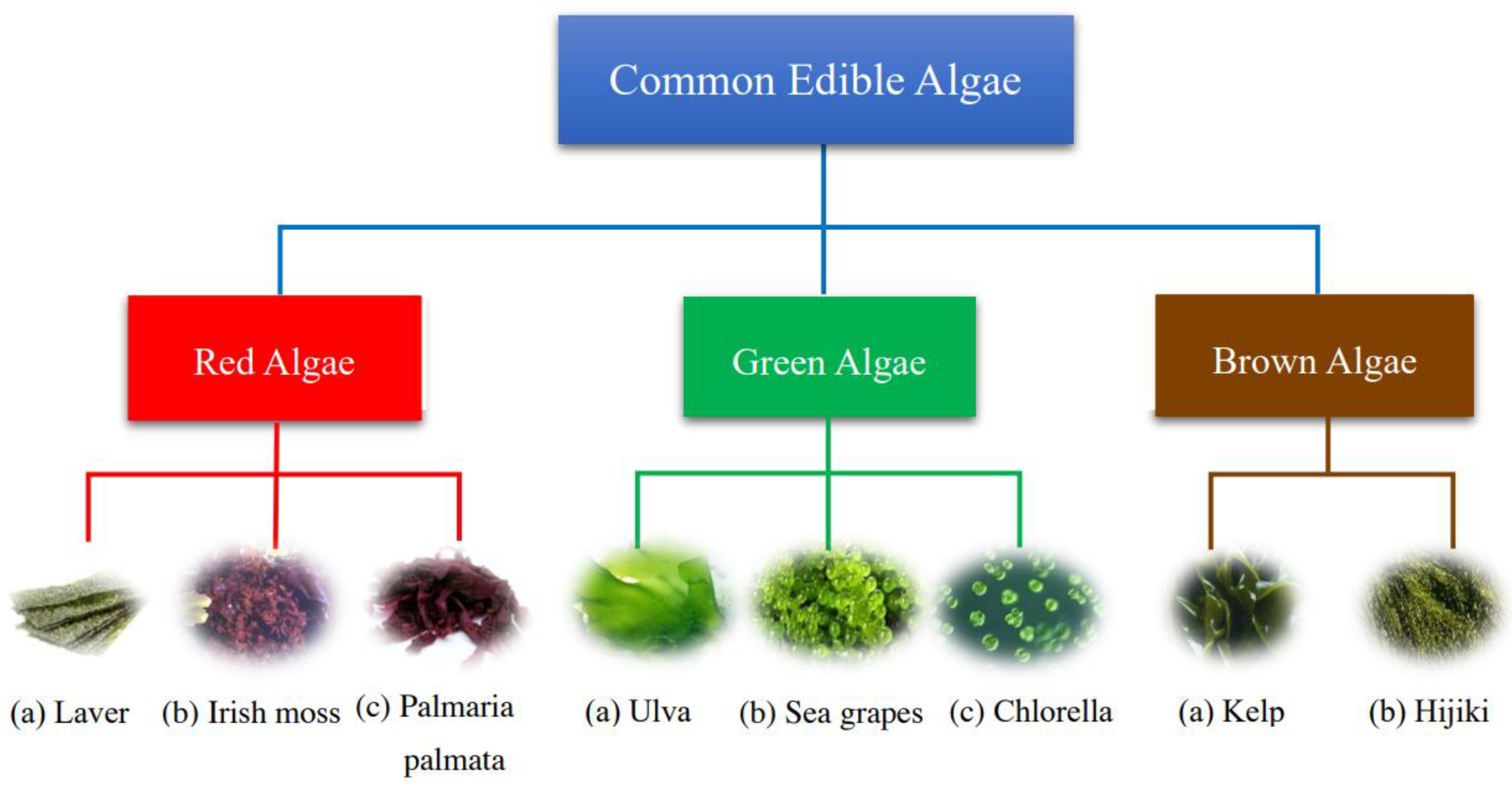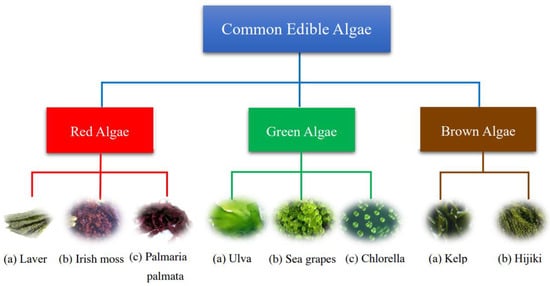With the rapid development of the economy and productivity, an increasing number of citizens are not only concerned about the nutritional value of algae as a potential new food resource but are also, in particular, paying more attention to the safety of its consumption. Many studies and reports pointed out that analyzing and solving seaweed food safety issues requires holistic and systematic consideration. The three main factors that have been found to affect the food safety of algal are physical, chemical, and microbiological hazards. At the same time, although food safety awareness among food producers and consumers has increased, foodborne diseases caused by algal food safety incidents occur frequently. It threatens the health and lives of consumers and may cause irreversible harm if treatment is not done promptly. A series of studies have also proved the idea that microbial contamination of algae is the main cause of this problem. Therefore, the rapid and efficient detection of toxic and pathogenic microbial contamination in algal products is an urgent issue that needs to be addressed. At the same time, two other factors, such as physical and chemical hazards, cannot be ignored. TNowadays, the detection techniques are mainly focused on three major hazards in traditional methods. However, especially for food microorganisms, the use of traditional microbiological control techniques is time-consuming and has limitations in terms of accuracy. TIn recent years, these two evaluations of microbial foodborne pathogens monitoring in the farm-to-table chain have shown more importance, especially during the COVID-19 pandemic. Meanwhile, there are also many new developments in the monitoring of heavy metals, algal toxins, and other pollutants. In the future, algal food safety risk assessment will not only focus on convenient, rapid, low-cost and high-accuracy detection but also be connected with some novel technologies, such as the Internet of Things (artificial intelligence, machine learning), biosensor, and molecular biology, to reach the purpose of simultaneous detection.
1. Introduction
Algae are among the most common organisms on earth and are defined as a class of autotrophic plants with no differentiation of roots, stems, and leaves; no vascular bundles; and containing photosynthetic pigments in terms of biology
[1]. Most of them exist in aquatic environments, but a few live in terrestrial habitats, meanwhile they can grow in both fresh and saltwater
[2]. For example, the well-known
Chlorella,
Spirogyra,
Chlamydomonas, and
Pandorina are grown in freshwater. On the contrary, marine algae, such as diatoms, brown algae, green algae, and red algae, grow in seawater. Previous studies have proved that algae are able to survive in extreme conditions
[3][4][3,4]. Regarding the number of seaweeds, Guiry reported in 2012 that he used the online taxonomic database, AlgaeBase, and found that the number of algae described reached an astonishing 350 million
[5]. As a result, the population of algae is quite enormous. Based on this reason, the study of the value and application of the most abundant algae has attracted a large number of researchers. On account of the urgent demand for renewable and clean energy in human society, the current research scope on algae mainly focuses on seaweed plants as a renewable and sustainable energy source. For instance, some researchers and research institutions have used microalgae as biomass to produce renewable and sustainable energy. As early as 2014, Kim changed the concentration of carbohydrates in the endophytic substances of microalgae by adopting the method of nutrient stress culture, and 89% of hydrolysates of microalgae could be successfully converted into ethanol fuel under the condition of continuous immobilized yeast fermentation
[6]. At that time, using microalgae as a carbon source raw material to produce bioethanol became one of the hotspots of this field. Meanwhile, microalgae are also known as the third generation of bioethanol different from traditional energy sources. Furthermore, biodiesel has been produced from the extraction of lipid-rich algae, such as
Chlorella,
Selenoses, and
Dinoflagellates, over the past decade and methods of extraction have also been improved
[7][8][9][10][7,8,9,10]. In addition to the development of new liquid fuels, research on solid fuels is not standing still. Because microalgae are excellent biomass feedstock, which have advantages, including high calorific value and clean and environmental properties. Therefore, it is processed into biochar by pyrolysis, drying, and carbonization to replace traditional coal
[11]. Unlike the above use of microalgae as biomass to produce biodiesel and bioethanol, Chia (2022) proposed that using algae-based microbial fuel cells has great potential to replace current non-renewable fuels (oil, coal) and solve the current international carbon neutrality problems (climate change, environmental pollution, energy shortage), and the cost of production is lower than that of microalgae biodiesel and bioethanol
[12].
Regarding the classification of seaweed products, in general, edible seaweeds can be broadly divided into three categories: red, green, and brown algae
[13]. To address the problem of hunger on a global scale, governments and organizations need to take immediate action to transform agri-food systems if they are to meet their commitment to end hunger by 2030
[14]. Therefore, algae are particularly important as a sustainable edible resource
[15]. Along with the rapid development of the economy and productivity, people in many countries pay more attention to their own diet health and nutrition. As a result, algae food is favored by consumers because of its high nutrient content. Numerous researchers have shown that seaweeds are rich in proteins, carbohydrates, lipids, and polyunsaturated fatty acids (PUFAs)
[16][17][16,17]. It is interesting to note that the quality of algal protein is better than that of other plant sources, including wheat, beans, or rice
[18]. Moreover, seaweeds contain various vitamins: A, B
1, B
12, C, D, and E, riboflavin, niacin, pantothenic acid, and folic acid, etc.
[19]. Algae are also rich in trace elements and minerals
[20]. In addition, some recent researchers have found that it also has dietary fiber
[21][22][23][24][21,22,23,24], known as the seventh nutrient. Hence, seaweeds are increasingly important as a food resource and are made into medicine and health care products. At the same time, current biologists and chemists pay particular attention to bioactive substances and functional mechanisms of algae.
2. Classification of Algal Food
Regarding the classification of algae, the Irish botanist and algologist William Henry Harvey first proposed in 1836 to divide known algae into four categories, according to the color of their thallus
[25][31]. Over the past three centuries, along with the development of science, the classification method became a comprehensive system. At present, the widely accepted method of classification is broadly divided into two types. The first classification method is to classify algae into macroalgae and microalgae, according to their size. Another classification is to distinguish the pigment contained in the algal cells, as well as reserved metabolites and cell wall composition. All edible algae known to humans can be classified into these three different types by color (
Figure 1). Regarding red seaweeds, laver is the one of most common edible red algae in daily life because of a great deal of people’s consumption. According to biological classification, it belongs to the genus of
porphyra. In addition, laver is particularly popular in Asian countries, especially in China, Japan, and South Korea. This is due to seaweed not only being able to be eaten directly by drying, baking, and souping
[26][32] but also because consumers can use laver as a raw material to make other foods, such as sushi and rice ball. On the other hand, there are different eating habits of Asian people; some citizens who live in Western countries have a particular fondness for Irish algae (Irish moss) and
Palmaria palmata (dulse) as their food and food supplement. According to a study in Europe in 2021, the researchers found that dulse is also widely used locally as a heavy source of food and medicine
[27][33].

Figure 1.
Classification and designation of common edible algae.
In terms of green algae, the most widespread is named Ulva, it can be found almost everywhere from Alaska to South Korea. It has been used in salads and soups in Scotland and Ireland in recent years. However, it is commonly used as a condiment in East Asia now
[28][34]. Up to now, several studies have shown that it contains a lot of amino acids, vitamin E, fatty acids, and dietary fiber nutrients, so consumers now pay abundant attention to the product and not just as a seasoner
[28][29][30][31][34,35,36,37]. Second, sea grapes are a general term for edible species of green seaweed belonging to the genus of
Caulerpa [32][38]. It grows mainly in the Indo-Pacific region and has a slightly salty taste
[33][39]. Finally,
Chlorella is a very famous green algae group in microalgae, due to it being rich in proteins, lipid polysaccharides, carotenoids, and other active substances, known as the new resources of edible algae in the future
[34][35][40,41].
With regard to brown seaweeds, they are called brown algae because their color depends on the ratio of the brown pigment (fucoxanthin) to the green pigment (chlorophyll)
[36][42]. The most famous brown seaweeds are kelp and hijiki. In terms of kelp, it is also referred to as bamboo seaweed and paddle weed. Based on the classification of the genus algae, it belongs to the genus of
Laminaria [37][43]. It is popular for its high nutritional value and contains a mass of various nutrients, such as protein, carbohydrates, vitamins, amino acids, and minerals
[38][44]. Recent studies have shown the regulatory effect of polysaccharides in hijiki on the intestinal flora. Its ethanol extract can regulate intestinal flora and metabolites in patients with type II diabetes so that it can reduce high-fat diet/Streptozotocin (HFD/STZ) to induce hyperglycemia
[39][40][45,46].
3. Algal Application in Food Industry
In meat-processing plants, algae used to be added as a food additive to improve shape and taste
[41][47]. With the advent of artificial meat, algae with high protein content have become a novel source of high-quality protein. Most of this plant protein is microalgae, such as
Spirulina,
Chlorella, etc. They are widely used by researchers to develop meat substitutes
[42][43][48,49]. Currently, nutritionists confirm that
Spirulina is an excellent source of natural protein food, and it contains up to 60–70% protein content, where human absorption rate are up to 95%
[44][45][50,51]. This is great news for vegetarians and researchers developing alternative plant proteins. In the beverage industry, algae provide an enormous supply of bioactive ingredients, and lots of studies use different types of algae to make functional drinks. As early as 2003, Takeshi Nagai and Takakiyo Yukimoto successfully made drinks from four different kinds of seaweed and tested their anti-oxidation function. The results showed that these drinks had strong antioxidant activity
[46][52]. Now a new study shows the novel trend of a drink made from seaweeds have the amount of untapped potential that can protect human health
[47][53]. Comparing edible seaweeds with commercially available dairy products, the calcium of cheese cannot be absorbed by consumers who lack enzymes to digest casein. However, those people can absorb calcium directly from algal foods. Therefore, the calcium of seaweeds is better than that of dairy products from the perspective of biological absorption and utilization
[48][54]. Additionally, while dairy products are the main recognized dietary source of calcium, and the average calcium content of dairy products is 100 mg/100 g
[49][55], compared with the calcium level of seaweeds, such as the calcium of the red seaweed
Lithothamnion, which accounts for 31% of its weight
[50][56], the content is significantly higher than the average calcium content of dairy products.


